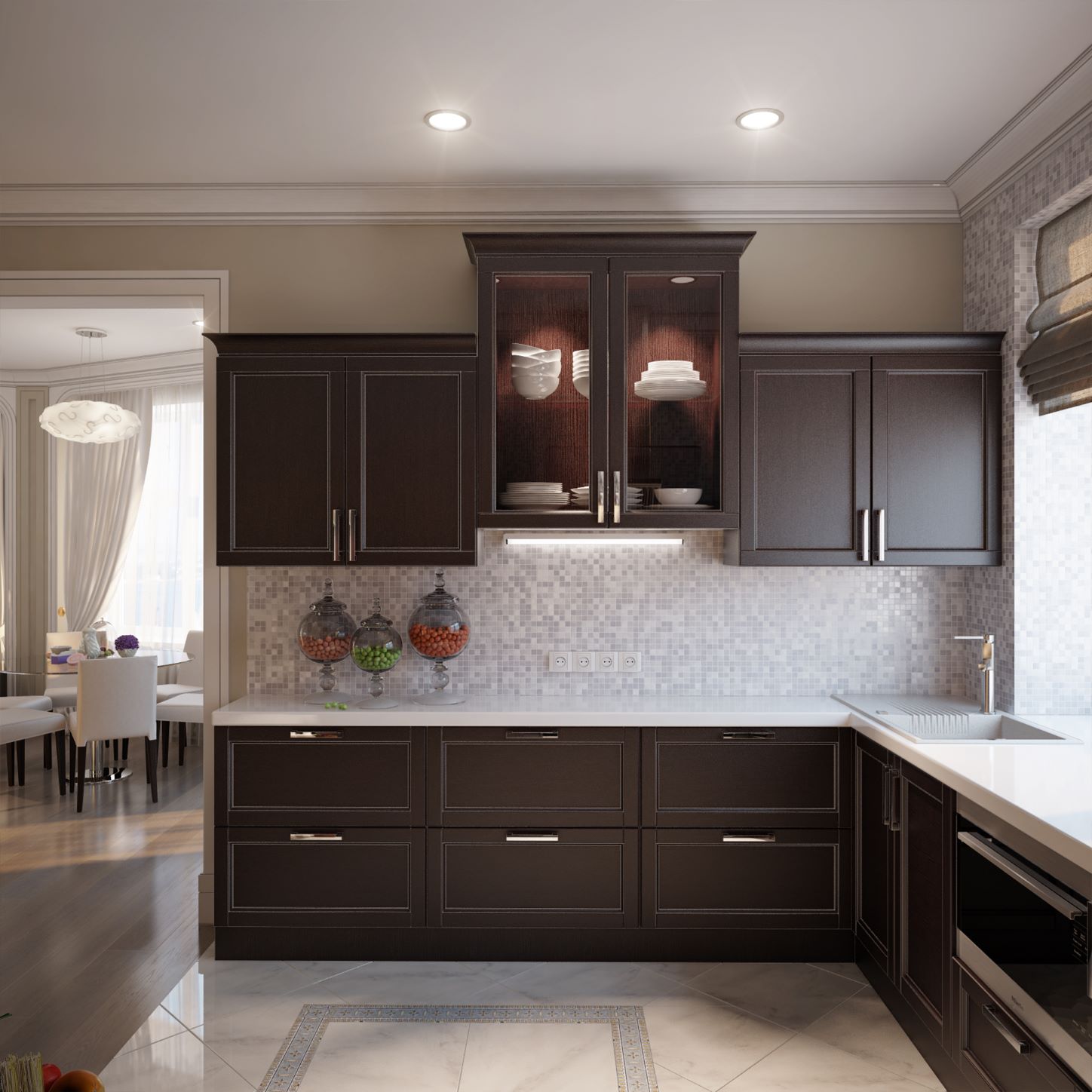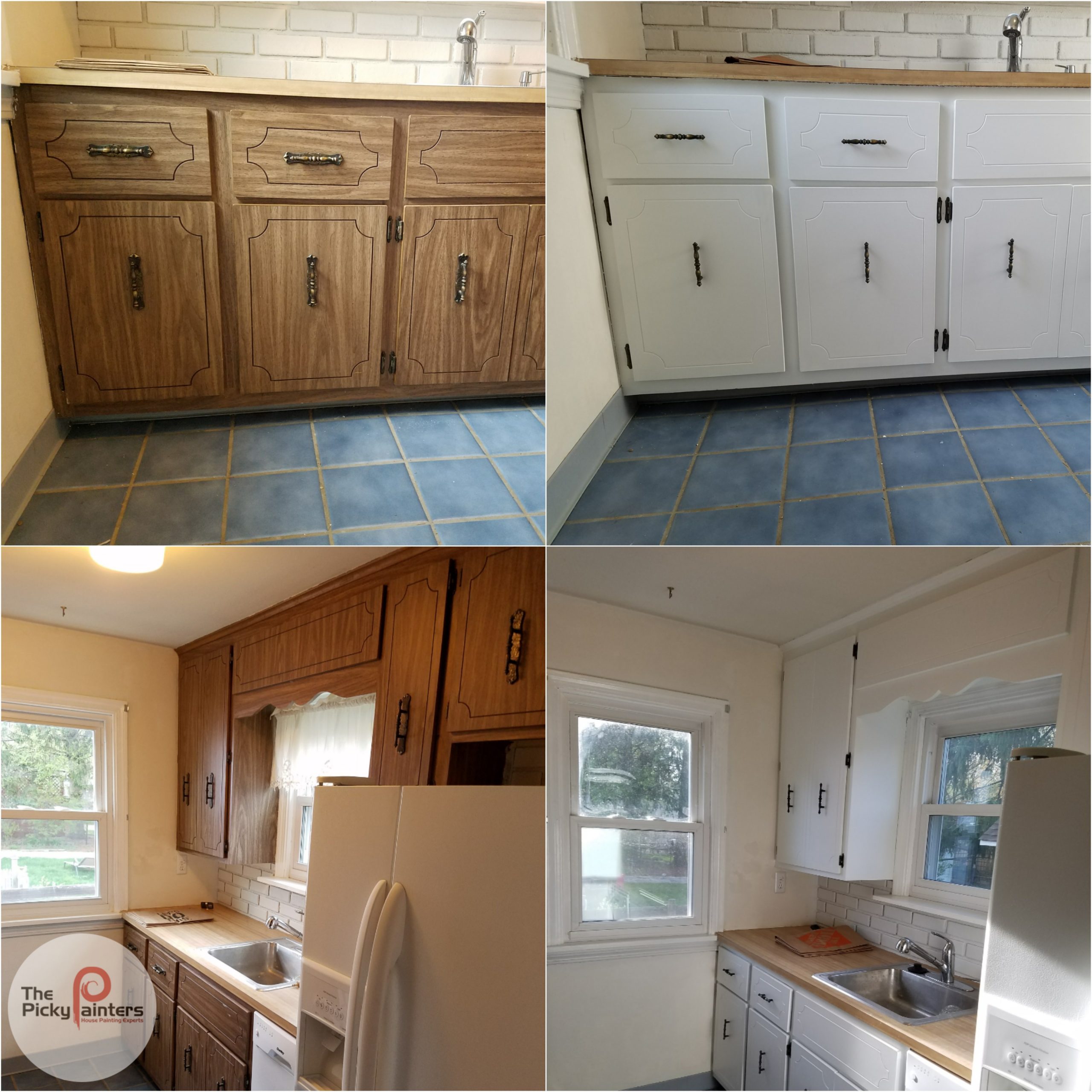Preparing Laminate Cabinets for Painting

Painting laminate cabinets can dramatically update a kitchen’s aesthetic, but success hinges on meticulous preparation. Failing to properly prepare the surface will result in poor paint adhesion, leading to peeling, chipping, and an overall unsatisfactory finish. This process requires attention to detail and the use of appropriate materials.
Surface Cleaning and its Impact on Paint Adhesion
Thorough cleaning is paramount for optimal paint adhesion. Dirt, grease, and other contaminants create a barrier between the paint and the laminate, preventing proper bonding. This can lead to premature paint failure. The choice of cleaning agent depends on the type and extent of the grime present.
- For light grime, a solution of warm water and mild dish soap is usually sufficient. Apply the solution with a soft sponge or cloth, rinsing thoroughly with clean water and allowing the cabinets to dry completely.
- Stubborn grease or oil stains may require a degreaser. Choose a degreaser specifically designed for use on kitchen surfaces and follow the manufacturer’s instructions carefully. Always test in an inconspicuous area first to ensure it doesn’t damage the laminate.
- For heavily soiled cabinets, consider using a TSP (trisodium phosphate) solution. TSP is a powerful cleaner that effectively removes grease and grime, but it’s crucial to wear protective gloves and eye protection when handling it. Thorough rinsing is essential after using TSP.
Sanding Laminate Cabinets
Light sanding helps to improve paint adhesion by creating a slightly rough surface for the paint to grip. However, excessive sanding can damage the laminate, so a gentle approach is crucial. Different grit levels of sandpaper serve different purposes in this process.
| Grit | Use | Description |
|---|---|---|
| 80-100 grit | Initial sanding (if necessary) | Removes significant imperfections or old finishes. Use sparingly. |
| 120-150 grit | Smoothing | Removes minor imperfections and creates a slightly textured surface for better paint adhesion. |
| 220 grit | Final sanding | Smooths the surface, preparing it for primer. Use lightly to avoid excessive scratching. |
Primer Selection and Application for Laminate Surfaces
Primers designed for laminate surfaces are essential for ensuring paint adhesion. They create a bonding layer between the laminate and the paint, preventing peeling and chipping. Different primer types offer varying benefits.
- Adhesion primers: These primers are specifically formulated to adhere to slick surfaces like laminate. They create a strong bond, improving paint durability.
- Oil-based primers: Offer excellent adhesion and blocking properties, preventing stains from bleeding through the paint. However, they have a strong odor and require longer drying times.
- Water-based primers: Low odor, quick-drying, and easy to clean up. They provide good adhesion, but may not be as effective as oil-based primers on extremely slick surfaces.
Choosing the Right Paint and Application Methods: Can You Paint Over Cabinets Laminate

Painting laminate cabinets successfully hinges on selecting the right paint and employing the correct application techniques. The durability and final appearance of your project are directly impacted by these choices. Ignoring these crucial steps can lead to peeling, chipping, and an overall unprofessional look.
Paint Type Comparison, Can you paint over cabinets laminate
The choice of paint significantly influences the final outcome. Different paint types offer varying levels of durability, application ease, and cost. The following table compares common options:
| Paint Type | Durability | Application Method | Cost |
|---|---|---|---|
| Acrylic (Water-Based) | Good; durable enough for moderate wear and tear. May require multiple coats for optimal coverage on laminate. | Brush, roller, sprayer. Easy cleanup with soap and water. | Moderate; generally less expensive than oil-based paints. |
| Oil-Based | Excellent; highly durable and resistant to chipping and scratches. Provides a harder, more protective finish. | Brush, roller. Requires mineral spirits for cleanup. | High; typically more expensive than acrylic paints. |
| Epoxy | Exceptional; extremely durable and resistant to chemicals and moisture. Ideal for high-traffic areas. | Brush, roller, sprayer. Requires specialized cleaning solutions. | High; often the most expensive option. |
Step-by-Step Painting Guide
Proper preparation is key to a successful paint job. These steps ensure a smooth, even finish on your laminate cabinets:
- Thoroughly clean the cabinet surfaces with a degreaser to remove any grease, grime, or silicone residue. Allow to dry completely.
- Lightly sand the laminate surfaces with fine-grit sandpaper (220-grit or higher) to create a slightly textured surface that will help the paint adhere better. Wipe away dust with a tack cloth.
- Apply a high-quality primer specifically designed for laminate or glossy surfaces. This helps the paint adhere and prevents peeling. Allow to dry completely according to the manufacturer’s instructions.
- Apply the first coat of paint using long, even strokes. For best results, use a high-quality brush or roller. Allow to dry completely.
- Lightly sand the first coat with very fine-grit sandpaper to smooth out any imperfections. Wipe away dust with a tack cloth.
- Apply a second coat of paint, following the same technique as the first coat. Allow to dry completely.
- Apply additional coats as needed to achieve the desired level of coverage and opacity.
Appropriate Painting Tools and Techniques
The right tools are essential for achieving a professional finish. Different paint types require different tools and techniques:
- Acrylic Paints: High-quality synthetic brushes and rollers are ideal. Sprayers can also be used, but require careful control to avoid runs and drips. Cleanup is easy with soap and water.
- Oil-Based Paints: Natural bristle brushes are generally preferred for oil-based paints, as they hold more paint and provide a smoother finish. Rollers designed for oil-based paints should also be used. Cleanup requires mineral spirits.
- Epoxy Paints: Specialized brushes and rollers may be required, depending on the specific epoxy paint used. Consult the manufacturer’s instructions for recommendations.
Brushstroke Technique
Imagine a large “W” shape being painted, then fill in the center of the “W” to cover the entire area. The initial strokes are long, smooth, overlapping slightly to avoid visible brush marks. Subsequent strokes fill in any gaps and blend the paint for a seamless finish. The focus is on consistent pressure and smooth, controlled movements, working from top to bottom, ensuring even coverage.
Addressing Common Issues and Troubleshooting

Painting laminate cabinets presents unique challenges. The non-porous surface of laminate can make paint adhesion difficult, leading to several potential problems. Understanding these issues and employing the right techniques is crucial for a successful and long-lasting finish. This section addresses common problems and provides solutions for achieving a professional-looking result.
Common Painting Problems and Solutions
Several issues frequently arise when painting laminate cabinets. Chipping, peeling, and an uneven finish are among the most common complaints. These problems often stem from inadequate surface preparation, improper paint selection, or incorrect application techniques. Addressing these issues proactively can prevent costly repairs and ensure a durable finish.
- Chipping: Chipping usually indicates poor adhesion between the paint and the laminate surface. This is often caused by insufficient cleaning and priming. Thorough cleaning and the use of a high-quality bonding primer are essential to prevent chipping. Areas prone to impact, such as cabinet edges and corners, may benefit from additional coats of paint or a protective sealant.
- Peeling: Peeling paint typically signals a lack of adhesion, often due to moisture trapped beneath the paint. Ensure the cabinets are completely dry before painting. Using a high-quality, moisture-resistant paint is also crucial. Proper surface preparation, including sanding to create a slightly rough surface for better paint adhesion, is also vital.
- Uneven Finish: An uneven finish often results from applying paint too thickly, using an inappropriate brush or roller, or failing to smooth out brush strokes properly. Applying thin, even coats and using a high-quality brush or roller with a smooth finish is critical. Lightly sanding between coats can also improve the final finish.
Addressing Paint Application Issues
Achieving a smooth, professional-looking finish requires attention to detail during the application process. Drips, runs, and brushstrokes are common issues that can detract from the overall appearance.
- Drips and Runs: Drips and runs are usually caused by applying paint too thickly or working too quickly. Use a high-quality paint with a good flow and leveling properties. Apply thin coats and allow sufficient drying time between coats. Using a brush or roller with the appropriate nap length for the paint type can also help minimize drips and runs. For large surfaces, a sprayer may offer a more even coat, reducing the risk of drips and runs.
- Brushstrokes: Visible brushstrokes indicate that the paint hasn’t been blended smoothly. Use a high-quality brush or roller and apply thin, even coats, working in the same direction to minimize brushstrokes. Allow ample drying time between coats. Lightly sanding between coats can help smooth out any visible brushstrokes.
Repairing Imperfections After Drying
Even with careful application, minor imperfections might occur. Addressing these promptly is important to maintain the overall quality of the painted finish.
Minor scratches or chips can be repaired using touch-up paint. For larger imperfections, sanding the area smooth and reapplying paint may be necessary. If the damage is extensive, repainting the entire cabinet may be required. Remember to always use a paint that matches the original color and finish. A fine-grit sandpaper and careful application will help to blend the repair seamlessly with the existing paint.
Maintaining the Painted Finish
Proper maintenance is key to prolonging the lifespan of your painted laminate cabinets. Regular cleaning and protection will help keep them looking their best for years to come.
- Cleaning: Regularly wipe down the cabinets with a soft, damp cloth to remove dust and dirt. Avoid harsh chemicals or abrasive cleaners that can damage the painted surface. For stubborn stains, use a mild soap and water solution. Always rinse thoroughly and dry with a soft cloth.
- Protection: Applying a protective sealant or clear coat after painting can help protect the surface from scratches and damage. This is especially important in high-traffic areas. Regularly inspect the cabinets for any signs of damage and address them promptly to prevent further deterioration.
